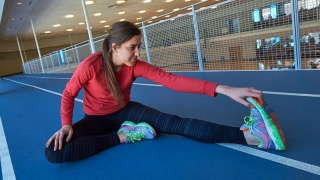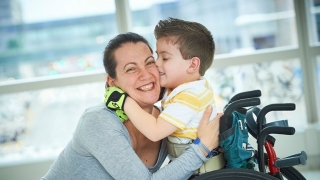Diastrophic Dysplasia
What is diastrophic dysplasia?
Diastrophic dysplasia is a disorder of cartilage and bone development that leads to an onset of joint pain and deformity. It is a rare genetic condition that causes dwarfism, where a child’s legs and arms do not grow and develop to the typical adult length. The word “dysplasia” refers to abnormal growth.
Diastrophic dysplasia occurs equally in males and females and most often in whites. It happens once in every 500,000 births in the United States.
At birth, babies with diastrophic dysplasia tend to be shorter, usually about 16.5 inches long. On average, most newborns are between 19 and 21 inches long.
Children born with diastrophic dysplasia have normal intelligence; however they may do physical things — like rolling over, sitting up and walking — later than other children.
Causes
Diastrophic dysplasia is caused by an autosomal recessive disorder on the gene called DTDST, which means both parents must carry this abnormal gene to have a child with diastrophic dysplasia.
Signs and symptoms
Symptoms of diastrophic dysplasia can include:
- Shortening of the limbs
- Scoliosis and increased lumbar lordosis with a prominent abdomen
- Hip dysplasia, in which the two hip joints are misaligned or crooked
- Deformities of the joints
- Foot deformities
- Hernia
- Cauliflower ear, a deformity of the cartilage of the ear
- Cleft palate, an opening or gap in the roof of the mouth
- Hitchhiker’s thumb, where the thumb sticks out at a right angle to the hand, looking like the child is trying to hitch a ride
- Brachydactyly, in which one or more of the fingers is abnormally short
Testing and diagnosis
Diagnostic evaluation for diastrophic dysplasia begins with a thorough medical history and physical examination of your child. At Children’s Hospital of Philadelphia (CHOP), clinical experts use a variety of diagnostic tests to diagnose diastrophic dysplasia and possible complications, including:
- X-rays, which produce images of bones.
- Magnetic resonance imaging (MRI), which uses a combination of large magnets, radiofrequencies and a computer to produce detailed images of organs and structures within the body.
- Computed tomography (CT) scan, which uses a combination of X-rays and computer technology to produce cross-sectional images ("slices") of the body.
- EOS imaging, an imaging technology which creates 3-dimensional models from two planar images. Unlike a CT scan, EOS images are taken while the child is in an upright or standing position, enabling improved diagnosis due to weight-bearing positioning.
- Blood tests, which can help determine drug usage and effectiveness, biochemical diseases and organ function.
- Genetic testing, in which a sample of your child’s saliva is used to identify your child’s DNA.
- Radioisotope bone scan, which can help locate areas of abnormal growth.
- Arthrography, which uses colored dye injected into a joint — most commonly the shoulder, hip, knee, elbow or wrist — and X-ray images are taken to identify any problems.
Treatment
Treatment for diastrophic dysplasia is multi-pronged because the condition affects several body systems. In some cases, careful monitoring may be all that is required. In other cases, nonsurgical or surgical treatments may be needed to address specific aspects of the condition.
At Children’s Hospital of Philadelphia, we practice collaborative, family-centered care. A team of expert clinicians — including leading orthopaedic surgeons and physicians, pediatric nurses, physical and occupational therapists, psychologists and other specialists — will partner with you in the care of your child.
Many children with diastrophic dysplasia are also diagnosed with a variety of orthopaedic conditions including: scoliosis, hip dysplasia, and hand and foot anomalies. In some cases, these conditions are present at birth and can be treated when the child is young.
For example, a child with hitchhiker’s thumb will likely need hand surgery; while a child with a bowed leg may only need a long-leg cast. Orthopaedic specialists from our Hand and Arm Disorders Program and Leg and Foot Program will work with your family to create an individualized care plan for your child.
In other cases the complication from diastrophic dysplasia may only become evident — or problematic — as your child grows. This is often true for spinal deformities such as scoliosis and hip conditions.
Depending on your child’s needs, orthopaedic specialists from our Spine Program and/or our Hip Disorders Program will treat and follow your child.
Every child’s condition is different, so treatment is determined on a case-by-case basis. For example, if your child has scoliosis, our team of specialists will consider the severity of the curve, where it occurs in the spine, and your child's age and stage of growth, before determining the best course of action.
Treatment may include nonsurgical options such as bracing and physical therapy, or surgical options such as spinal fusion or implanting growing rods to stabilize your child’s spine as she continues to grow.
Follow-up care
Your child with diastrophic dysplasia should continue to be monitored by an orthopaedic physician into adulthood. Annual visits to follow the development of the spine and hips is appropriate.
If your child had spine surgery, he or she will need to see the orthopaedic surgeon about one to two weeks after surgery, then again at three and six months post-surgery. After that, annual monitoring by trained clinicians is strongly encouraged to ensure any problems are spotted and treated as soon as possible.
Additionally, physicians may recommend your child see several different specialists because so many body systems are involved in a diagnosis of diastrophic dysplasia.
For example, your child may see:
- An otolaryngologist or plastic surgeon for cleft palate
- A geneticist for individual or family counseling
- An orthopaedist for any bone- and muscle-related issues
- A pulmonologist for any breathing issues
- Physical therapists and occupational therapists to expand your child’s physical dexterity and skill
- Nutritionists to improve your child’s dietary health
During follow-up visits, X-rays and other diagnostic testing may be done. The goal of continued monitoring is to help spot any irregularities in growth or development and to address health issues as they develop.
Follow-up care and ongoing support and services are available at our Main Campus and throughout our CHOP Care Network. Our team is committed to partnering with parents and referring physicians to provide the most current, comprehensive and specialized care possible for your child.
Outlook
Children with diastrophic dysplasia can lead normal lives. They can hold good jobs, get married, have children and more.
If you have questions about how your child’s condition and any related health issues may affect your child’s prognosis or long-term goals, talk to your child’s healthcare provider.
Reviewed by: Denis S. Drummond, MD
Date: May 2013








